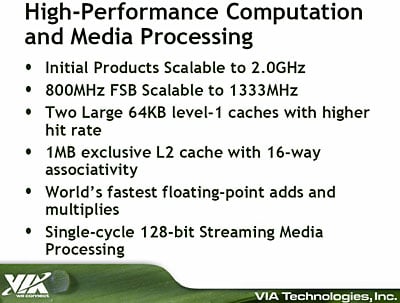VIA's Glenn Henry Speaks On New Low Power Isaiah Processor
Q: Initial Isaiah based processors are said to be pin compatible with the C7, which will make it easy for partners to adopt them for existing designs. This leads us to believe a new pin-out is planned for future revisions of the core, however. If that is the case, can you comment on some of the new features that might come along with a new pin-out?
VP of Marketing, Richard Brown |
Glenn Henry: At this point we have no plans to bring out a new pin-out for the chip and there is no perceived need to take the design beyond our current footprint. In the future, if there’s some obvious market need, we would of course react to that.
Glenn Henry: You should probably talk to a few of our marketing guys on this one but personally, I don’t think we’ll see a new class of devices spring up from the introduction of Isaiah. However, we will make the existing laundry list of devices more functional and useful. Here’s a personal example. I have an OQO UPMC that runs Windows XP really well on our C7 processor. One of our Engineers here tried to install Vista on it and wasn’t happy at all with the performance. Vista just consumes a lot of processing power. I don’t want to say it’s a CPU hog (nah! why would he say that?) but this is just an example of how we’ll make current existing devices more capable and useful. So maybe they can process not just MPEG2 but also MPEG4 content and run Vista on these machines; stuff like that. Also, from our personal viewpoint, this chip will make us a lot more competitive in low-end desktops and notebooks. HP in China uses our C7 in a low cost desktop, for example and Isaiah will benefit them greatly by doubling their available performance.
Glenn Henry: I don’t want to quote anything on this topic because a large component of power consumption in ultra-mobile devices isn’t tied to CPU power consumption, so it would be hard to provide accurate projections. However, Isaiah consumes about the same amount of power as our current C7 processor. Where we’ll see big benefits will be in power efficiency. In other words, Isaiah will have higher overall processing throughput at relatively the same power consumption. So in that scenario, battery life should obviously be improved. It’s too complicated to say though really. There aren’t very good benchmarks in this area though, so we’ll have to see how it performs in real-world applications first. If statistics are lies, so to speak, then quoting power statistics in this area early on would be a worse lie. So we don’t want to go there.
Q: We know mobile internet devices (MIDs), ultra mobile PCs (UMPCs), and ultra thin and light, low power notebooks will feature Isaiah based processors. Do you also see a new class of devices being developed to take advantage of the increased performance and power characteristics of the Isaiah architecture?

Q: Can you comment on what some of the first devices to market with Isaiah based processors might look like? UMPCs, Notebooks, MIDs, Embedded apps?
Glenn Henry: I can’t stress enough the huge advantage we’ll have with being able to be compatible with current, legacy C7 designs. I can’t confirm this but I suspect the new products coming out will look like current design wins from OQO and others, etc. We have lots of UMPC type design wins, thin and light notebooks and other mobile devices. Obviously there will be a need for BIOS updates, engineering qualification etc, but current designs can pretty much just drop Isaiah right in. New designs take longer to bring to market obviously, so our compatibility will definitely get Isaiah to market and available in products much faster. Likely our customers will offer two SKUs, one with our C7 and an upgraded, faster Isaiah-based product.
Q: Roughly, what sort of battery life efficiencies can we expect from the new Isaiah core, in terms of percentages versus the C7 or even Silverthorne, if you can speculate on that?






